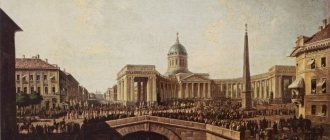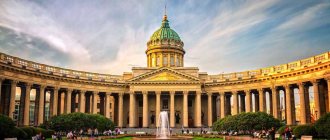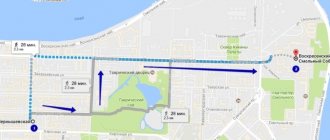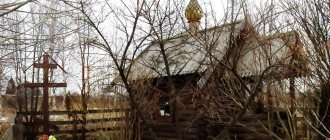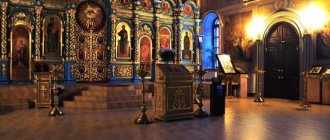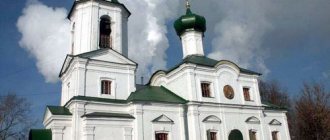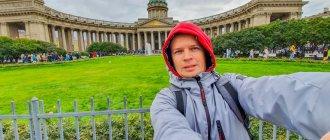The Kazan Cathedral in Volgograd (also the Cathedral of the Kazan Icon of the Mother of God) is located in the Voroshilovsky district. It is a cathedral and belongs to the Volgograd and Kamyshin diocese of the Russian Orthodox Church.
The cathedral is open daily from 07:00 to 19:00.
The Volgograd Cathedral attracts tourists with its complex history and beautiful interior decoration. You should set aside at least 30 minutes to get to know the property.
Interior of the temple, © Haitham El Shall
History of the Kazan Cathedral in Volgograd
The icon of the Kazan Mother of God remained unharmed during the fire of 1579, after which many copies were created, and the original was lost at the beginning of the 20th century. The Kazan Mother of God is considered the patroness of Rus' in troubled times.
The foundation of the first church was laid at the beginning of the 18th century. inside the Tsaritsyn fortress. A small wooden chapel near the cemetery, which occupied the entire Kuznetskaya street, with a picturesque view of the city. According to historical documents, it did not last long and subsequently burned down.
At the end of the 19th century. it was restored with money from parishioners. At the beginning of the 20th century. A shelter for holy fools was founded, where the famous blessed Adrian lived, as well as Tatyana and Catherine, famous in Tsaritsyn. The architectural complex of the building at that time included:
- temple,
- Bell tower
- refectory,
- parochial school for girls.
Until 1939, it accepted believers, despite numerous persecutions and robberies by the Soviet regime. All valuables were confiscated, and the building was given to the bakery.
During the Second World War, the church was almost completely destroyed down to the walls and foundation, and after the war it was given to believers. In the post-war years, people came to the walls of the temple with prayers and wrote messages to missing loved ones. Many church ministers were persecuted, but the parishioners did not leave the church.
At the end of the 40s of the XX century. the building was restored thanks to donations from parishioners. The Kazan Mother of God and the crucifix were returned to the cathedral. In the 50s the church was painted. And in 1954, it was awarded the rank of cathedral, that is, the main cathedral of the city, where the bishop conducts services.
In 2010, the cathedral required restoration, and the building was updated with funds from the budget of the Volgograd region, as well as with the help of a local philanthropist company. The church was restored to its pre-revolutionary appearance.
The cathedral is made in the shape of a cross. Red brickwork with stucco decorations, typical of Tsaritsyn (aka Volgograd) of the 19th century, pseudo-Russian style, famous for its eclecticism with the addition of ancient Russian elements. Instead of onion domes, tent domes were erected, adding 4 new ones. At the moment there are 6 of them. The territory of the Cathedral is paved with paving stones.
Church of All Saints (Volgograd)[edit]
The parish of All Saints was formed in 1993.
The idea of building a temple on the Mamayev Kurgan was born in June 1993, when His Holiness Patriarch Alexy II of Moscow and All Rus' visited Volgograd, who arrived together with Archimandrite Kirill (Pavlov), a participant in the Battle of Stalingrad. In the anniversary year of celebrating the 50th anniversary of the Stalingrad victory, the Patriarch consecrated the Mamayev Kurgan to build a temple on it so that people could light candles here in memory of the defenders of this height. In 1995, Patriarch Alexy blessed the construction of the temple in honor of All Saints. Design work began, as a result of which the current location for the temple was determined, located approximately 200 m from the Motherland monument near the mass grave. Geologists confirmed that the temple will not cause any damage to the Motherland monument and the entire architectural and artistic ensemble. But unexpectedly, the Volgograd administration opposed the construction. They cited the fact that the public and veterans do not want this. But a survey conducted in 1997 with the help of the regional military registration and enlistment office showed that 80 percent of veterans approve of the construction of a temple - a monument on Mamayev Kurgan.
Address:
400010, Volgograd, Mamayev Kurgan
Telephone:
+7 (8442) 24-15-14
Departments of the Cathedral
- A church shop where you can buy icons, church literature, souvenirs and other attributes.
- Sunday school “Kliros” for preschoolers and elementary school students. Studying the foundations of Orthodoxy and applied developmental disciplines.
- Spiritual singing school "Glas". Classes on liturgical practice and training in musical disciplines. Held on Sundays for children and adults.
- A school of bell ringing that produces professional bell ringers.
- Theater named after Talkova, who stages spiritual and folk-patriotic performances.
- Social department.
The cathedral cooperates with a number of colonies and provides all possible assistance to socially vulnerable people in need of help. On holidays and Sundays, charity tea parties are held.
Temple of John of Kronstadt (Volgograd)[edit]
On December 21 (8), 1991, His Eminence Herman, Archbishop of Volgograd and Kamyshin, performed the rite of consecration and laying the stone. This was the beginning of the future temple in honor of the holy righteous John of Kronstadt.
Before the consecration of the construction site with the blessing of Archbishop German, Sunday services were held at the proposed site, which were conducted by Priest Nikolai Babak and Priest Vladimir Prudnik before the onset of cold weather. Subsequently, a constituent assembly was created, by the decision of which on April 12, 1992, the parish of St. Righteous John of Kronstadt was organized.
In 1993, the Temple was visited by His Holiness Patriarch of Moscow and All Rus' Alexy II.
Address:
400040, Volgograd, Tumanyan st., 38.
Telephone:
+7 (8442) 73-09-91
Kazan Cathedral in Volgograd: useful information
- Address: Voroshilovsky district, Lipetskaya, 10.
- Telephone:
- Official website: https://volgograd-sobor.ru/
- Opening hours: the doors of the cathedral are open to everyone from 7:00 to 19:00.
- The schedule of services with detailed descriptions can be found on the official website for the week ahead. Morning and evening liturgies are held every day.
- The Kazan Cathedral belongs to the Volgograd diocese.
Shrines
The shrines of the Kazan Cathedral can be divided into 2 parts:
- Large reliquary. The relics of 23 saints, martyrs, saints and blessed ones are kept here.
- Icons. The valuable icons of the Kazan Cathedral in Volgograd include 5 sacred images, including the icon of the Holy Blessed Prince Alexander Nevsky with a particle of holy relics.
Interior of the temple, © Haitham El Shall
Current state[edit]
Interior decoration
Description[edit]
The plan of the church is traditional: the temple has the shape of a cross, built in the traditions of the Novgorod school. The building is brick.
In general, the style of the building is characteristic of the eclectic architecture of Tsaritsyn at the end of the 19th century. The building was built in pseudo-Russian style.
The facades are made of brickwork with the use of stucco parts in places. As art historians note, the decor of the temple elements is stylized to resemble ancient Russian forms.
Activities of the parish[edit]
- Sunday School
- School of ringing
- Church shop
Church of St. John the Baptist (Volgograd)[edit]
On July 2, 1589, with the construction of a wooden church in the name of St. John the Baptist, the Tsaritsyn fortress was founded. The church was built by Don (according to another version, Astrakhan) Cossacks. However, it stood for just over 10 years. A fire that occurred soon destroyed many of the wooden buildings of the new city. He did not spare the Baptist Church either. In 1615 the Temple was restored. The names of 6 builders who cut down the wooden Temple are known. These are: - Vasily Agafonov, Druzhina Ivanov, Foma Stepanov, Bogdan Kuzmin, Obrosim Klementyev, Ivan Sechenov. The Church of John the Baptist turned out to be closely connected with the development of monastic life in Tsaritsyn. Thus, in a letter to the sovereign dated 1653, the Don Cossacks mention the city’s Mother of God Monastery, dedicated to the Vladimir Icon of the Presentation of the Mother of God, where they go on pilgrimage. In the second half of the 17th century. it was abolished due to overcrowding, but on its basis in the 60s of the 17th century. The women's monastery of St. John the Baptist appears, the abbot of which from 1652 to 1658. was its builder, Father Macarius.
Address:
400066, Volgograd, st. Krasnoznamenskaya, 2.
Telephone:
38-09-55, 38-52-91
Church of the Great Martyr George the Victorious (Volgograd)[edit]
In 2005, by the decision of the shareholders of the company Minland Resources ltd and the director of Fomenko Alexey Petrovich, it was decided to erect a factory temple of St. George the Victorious. The name was not chosen by chance. As you know, St. George the Victorious is one of the most revered saints in Rus', the thousand-year-old patron of the Russian army. At the beginning of May, the Orthodox Church celebrates the day of remembrance of this saint. Veneration of St. George came from Byzantium after the baptism of Rus'. In the 18th century St. St. George the Victorious took a place on the coat of arms of Moscow; today his image is part of the All-Russian coat of arms.
On May 5, 2005, the site for the foundation of the temple was consecrated by Metropolitan German. At first, the construction of the temple was supervised by the diocese, Abbot Elisey (Fomkin), rector of the nearby Church of St. Righteous John of Kronstadt, he consecrated the foundation stone of the temple in the fall of 2005. The construction was coordinated by Igor Viktorovich Vazhenin from the plant. In the spring of 2006, Metropolitan German consecrated the bells of the belfry.
Address:
400007, Volgograd, Lenin Avenue, 110, .
Telephone:
+7 (884) 74-88-78
Transfiguration Church (Volgograd)[edit]
The parish was formed in 1992. Construction work has not yet been completed. A refectory and a bell tower were built. Divine services are held on Sundays and holidays. Two priests serve. There is a Sunday school "Blagost" and a library. A wooden baptismal church and a priest's house were built, and a wooden well was equipped. There is a subsidiary farm in the parish. The priest visits Lyceum No. 8 weekly.
Address:
400117, Volgograd, Kosmonavtov st., 16.
Telephone:
(8442) 91-53-95
St. Vladimir's Church (Volgograd)[edit]
On June 18, 1999, Metropolitan Herman of Volgograd and Kamyshin signed the Charter of the local Orthodox religious organization of the Holy Prince Vladimir of the Russian Orthodox Church of the Moscow Patriarchate. (Throne in the name of the Holy Equal-to-the-Apostles Grand Duke Vladimir - Baptist of Rus'. Day of celebration - July 28).
For the first time, residents of the Zhilgorodok microdistrict learned that a community of Orthodox Christians was being organized from advertisements posted by the first rector of the parish, Priest Andrei Seryogin. The first meeting of future parishioners took place on December 14, 1999 in library No. 22, located on the street. Republican. From this day on, the spiritual activity of the community began.
Address:
400075, Volgograd, st. Krasnopolyanskaya, 9
Telephone:
(8442) 54-33-62
Temple of St. Niketas of Midice (Volgograd)[edit]
St. Nikitsky Church is one of the few in the territory of modern Volgograd that survived Soviet times and has survived to this day. The church was built at the expense of Astrakhan Governor-General Nikita Afanasyevich Beketov at the end of the 18th century. Everyone who turned to its history faced the problem of more accurately dating the construction of the temple. One of the first to try to solve it more than a hundred years ago was the famous researcher of our region A. N. Minkh. In the “Historical and Geographical Dictionary of the Saratov Province” he wrote: “According to the information of the volost government, Nikita Afanasyevich Beketov built a church in Otrada in 1782 in the name of St. Nikita the Confessor, in honor of his angel, but according to archival documents (“Proceedings” of the Saratov Scientific Archival Commission of 1893 - issue 2, p. 106) it is shown that the Nikitin stone church in the village of Otrada was built in 1795, therefore, taking into account the time of Beketov’s death on June 9, 1794, probably this church was started only under him, and was consecrated in 1795, shortly after his death...” The temple was originally built in the form of a basilica. There were windows along the walls in two rows at a short distance from each other, thanks to which a lot of light came inside. The facades were painted light yellow.
Address:
400023 Volgograd (Beketovka) st. Abganerovskaya 110 a
Telephone:
+7 (8442) 44-58-87
Directions:
You can get to the temple by minibuses 1С, 3С, 56Э
Temple of St. Sergius of Radonezh (Volgograd)[edit]
Upon his arrival in Volgograd on June 20, 1993, His Holiness Patriarch Alexy II consecrated the site for the construction of a temple in memory of the 600th anniversary of the death of St. Sergius. A memorial plaque and a cross are placed here, which someone set on fire twice, but the fire was extinguished by the rain that began. Priest Viktor Ulyanov is appointed to the parish.
The construction is financed by M.V. Slesarenko, who created a public fund to promote the construction and maintenance of the Church of St. Sergius. Construction work began in February 1996. While construction was going on, services were held in a small chapel. On January 15, 1999, crosses were placed on the domes. On the same day, Bishop Herman serves the Divine Liturgy in one of the premises of the temple. The Archbishop consecrates the church on November 14, 1999.
Address:
Volgograd, st. Tkacheva 1
Telephone:
(88442) 36-85-52
